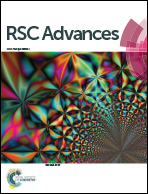Synthesis of nano-sized urchin-shaped LiFePO4 for lithium ion batteries†
Abstract
In this article, the facile synthesis of sea urchin-shaped LiFePO4 nanoparticles by thermal decomposition of metal-surfactant complexes and application of these nanoparticles as a cathode in lithium ion secondary batteries is demonstrated. The advantages of this work are a facile method to synthesize interesting LiFePO4 nanostructures and its synthetic mechanism. Accordingly, the morphology of LiFePO4 particles could be regulated by the injection of oleylamine, with other surfactants and phosphoric acid. This injection step was critical to tailor the morphology of LiFePO4 particles, converting them from nanosphere shapes to diverse types of urchin-shaped nanoparticles. Electron microscopy analysis showed that the overall dimension of the urchin-shaped LiFePO4 particles varied from 300 nm to 2 μm. A closer observation revealed that numerous thin nanorods ranging from 5 to 20 nm in diameter were attached to the nanoparticles. The hierarchical nanostructure of these urchin-shaped LiFePO4 particles mitigated the low tap density problem. In addition, the nanorods less than 20 nm attached to the edge of urchin-shaped nanoparticles significantly increased the pathways for electronic transport.



 Please wait while we load your content...
Please wait while we load your content...